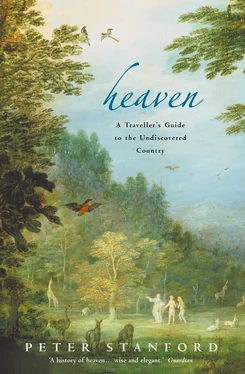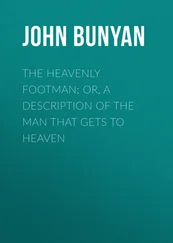The author of The Revelation to John recounts in classic apocalyptic style how a door was opened in heaven and an angel took him up to watch a heavenly liturgy. The spectacle is something of a cross between a tacky musical extravaganza, a freak show and a zoo, but it remains the most detailed – and the most quoted – of the Bible’s very few descriptions of the place of eternal rest for the faithful. God presides at the centre of events in human form, seated on a throne:
Round the throne in a circle were twenty four thrones, and on them I saw twenty-four elders sitting, dressed in white robes with golden crowns on their heads. Flashes of lightning were coming from the throne and the sound of peals of thunder, and in front of the throne were seven flaming lamps burning, the seven spirits of God. Between the throne and myself was a sea that seemed to be made of glass, like crystal. In the centre, grouped around the throne itself, were four animals with many eyes in front and behind. The first animal was like a lion, the second like a bull, the third animal had a human face and the fourth animal was like a flying eagle. Each of the four animals had six wings and had eyes all the way round as well as inside; and day and night they never stopped singing. (Rev 4:1–8)
As part of the liturgy, the four horsemen of the apocalypse appeared and were sent to earth to wreak God’s vengeance and dispense His judgement. There were, the author reported, a huge number of people in front of the throne who had been persecuted for faith. ‘The one who sits on the throne will spread His tent over them,’ the author writes, in what must be a direct reference to Paul. They would never go hungry or thirsty again. There would be no sun or wind to plague them because the Lamb who was at the throne would be their shepherd and lead them to the springs of living water where God would wipe away their tears.
The combination of the rituals of a secular court and a Christian liturgy is emphasised later in Revelation when the exact lay-out of heaven is given, based on a Jewish synagogue and the Temple itself. This new Jerusalem would be surrounded by high walls, with twelve gates, each watched over by a designated angel. It would be square in shape – 12,000 furlongs (1500 miles) long and 12,000 furlongs wide. The walls would be of diamonds (echoes of Enoch), and the city itself of pure gold that would have the appearance of polished glass. There would be no day or night – God would provide the light.
Any ambiguity about the new Jerusalem being real and concrete is abandoned by Revelation. It is self-consciously a work of imagination and dazzling imagery. Though it appears superficially to be endorsing the hopes of the Babylonian exiles in the Book of Isaiah, it is reinterpreting them, detaching heaven from this world and relocating it in the cosmos, albeit maintaining a symbolic link. So when the author writes of Jesus returning to earth, banishing Satan and initiating one thousand years of messianic rule (the biblical millennium which got fundamentalist Christians over-excited in 2000), he should not be taken too literally. After this one thousand years Satan’s power would be much reduced but he would still harry and mislead humankind. Finally, he would begin a final futile attack by besieging ‘the camp of the saints which is the city that God loves. But fire will come down on them from heaven and consume them’. In the moment of God’s ultimate triumph, the Book of Life would be opened. Those named in it would be saved and ascend to heaven, those not would be consigned to the depths with Satan.
Frustratingly, once again this heaven of the clouds is only partly described:
Then the angel showed me the river of life, rising from the throne of God and of the Lamb and flowing crystal clear down the middle of the city street. On either side of the river were the trees of life, which bear twelve crops of fruit in a year, one in each month and the leaves of which are the cure for all nations. (Rev 22:1–3)
The references to the throne at the centre of events suggests another possible reading – in line with Jewish Throne Mysticism – that would make Revelation a very dramatic vision of transcendence which exists behind outwardly recognisable phenomena and which may break out at the end of time. The author, in this scenario, was trying to envisage poetically, with equal measures of ecstasy and awfulness, the Second Coming and the presence of God on earth.
Despite its drama, end-of-time flavour and position as the eye-catching final act of the Bible cycle, Revelation can in no way be counted as resolving all remaining unanswered questions, least of all those about a mental, imaginary or physical heaven. Despite the lack of a clear vision for Christianity on the subject throughout the New Testament, at least the parameters of the debate had been established. By taking bodily resurrection from Judaism and the immortal soul from the Greco-Roman tradition, Christianity had the makings of a distinctive position. As yet that paradise was overshadowed by the anticipation of an actual Second Coming. When this failed to materialise, and as the early Christians suffered persecution and death for their new-found faith at the hands of the Roman Empire and its pagan citizenry, the issue of eternal fate gradually came more and more to the fore in the debate and divisions of the early Church Fathers.
CHAPTER FOUR The Compensation Culture
In its first half-millennium, Christianity grew from being a fringe cult in Galilee to multinational status as the official religion of the Roman Empire. If its rise was meteoric, it certainly wasn’t smooth. There were periods of intense persecution by the authorities, and even after the Church had seemingly reached a safe harbour by joining forces with the Roman establishment in AD 381, its problems were not all solved, for by AD 410 Rome itself was sacked by the Goths and the empire crumbled in the West, posing the challenge of a period of instability, decline and lawlessness.
Within the burgeoning Church community were many rows and splits. Once the hope of an imminent Second Coming, so tangible in the New Testament, had passed, the leadership began to adjust to working with, and explaining God’s role in, an imperfect world. They had to build a comprehensive theology to unite and bring order to their Church, based on ideas, which were often confused, passed down by the first generations of Christians. What ultimately emerged was certainly more systematic, more enforceable, though often no more coherent. In the case of heaven, this was the period in which the three distinct positions – theocentric, anthropocentric and a combination of both – emerged.
The names of three ‘early Church Fathers’ in particular dominate this era of consolidation, and they can mark for us the boundaries of the debate on the nature of heaven. These Church Fathers were not, as their designation suggests, a static group of theologians stooped endlessly over their Bibles. Indeed, there was as yet no Bible as we now know it (this was completed by Jerome, in c . AD 404). They were not only theologians, but administrators, builders, guides, preachers and proselytisers. The first of these remarkable men is Irenaeus of Lyons ( c . AD 130– c . 202), who, as a youth in Smyrna in Asia Minor, trained under Bishop Polycarp. Irenaeus later claimed that his mentor had ‘known John and others who had seen the Lord’. Details of Polycarp’s martyrdom are amongst the earliest recorded to have survived, and they give an insight into the persecution that the early Church routinely endured. Challenged by the Roman pro-consul in Smyrna to disown Christ, he refused and was burnt alive in 155. ‘The flames made a sort of arch, like a ship’s sail filled with wind, and they were like a wall around the martyr’s body; and he looked, not like burning flesh, but like bread in the oven or gold and silver being refined in the furnace.’ ( Ancient Christian Writers Series , Vol. 6)
Читать дальше












